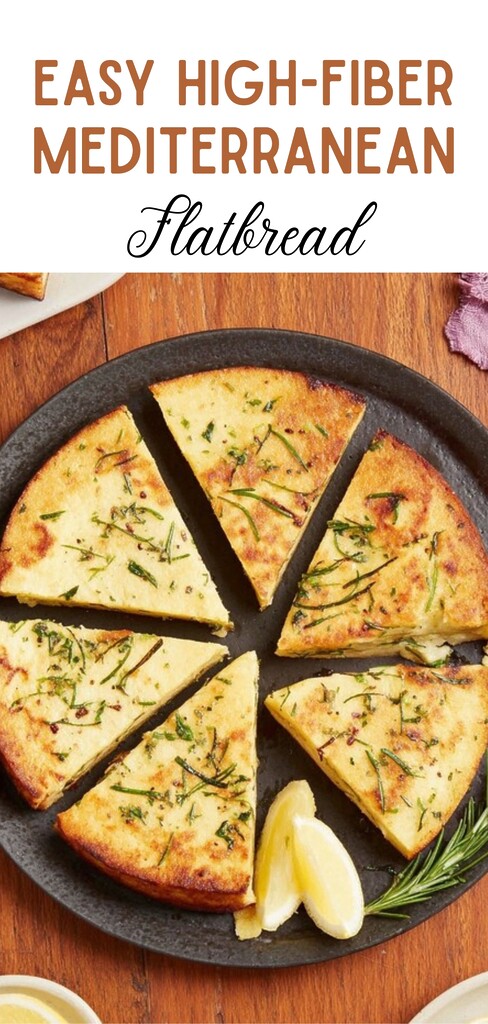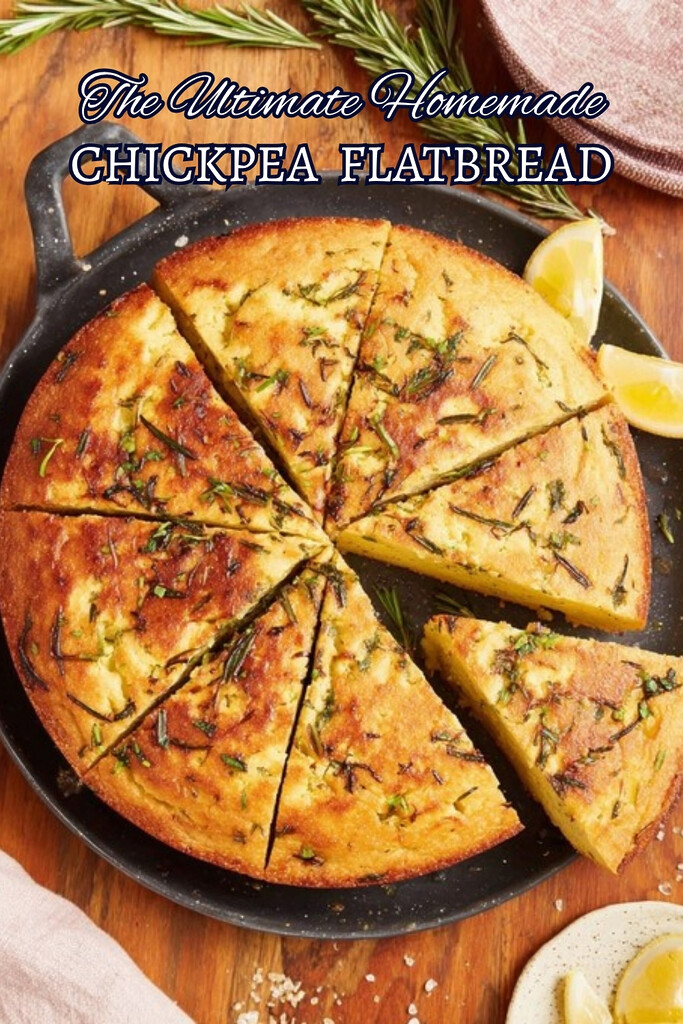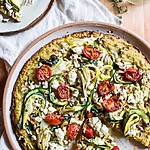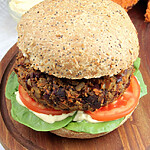Let’s be honest: a great socca is a completely different experience from a merely ‘okay’ one. For a long time, my homemade versions were missing that magic ‘something’ I’d tasted in Mediterranean cafes. They were often a bit too dense or lacked that savory, herby depth.
This is the recipe that changed everything. It’s the result of testing (and more testing!) to get that perfect balance: a wonderfully crispy, blistered edge from the cast-iron, a tender (never gummy!) center, and a huge flavor boost from fresh rosemary, oregano, and a touch of za’atar.
It’s become our family’s favorite savory, high-fiber flatbread, and it’s surprisingly simple to make.

A Savory, Satisfying Grain-Free Staple
What I love most about this socca recipe is how nourishing and satisfying it is. It’s built on a foundation of chickpea flour, which is a fantastic whole-food ingredient.
This flatbread is naturally grain-free and gluten-free, but it’s the nutritional profile that makes it a winner for me. It’s packed with 7 grams of protein and over 5 grams of fiber per serving (thanks to the flaxseed boost!). That’s the kind of combination that provides steady, reliable energy and keeps you feeling full and satisfied, which is exactly what I look for when tracking my family’s meals.
The Secret to That Perfect Blistered Crust
The technique here is just as important as the ingredients. Don’t worry, it’s easy, and it’s all about heat.
You’ll first whisk your simple batter (chickpea flour, flax, herbs, water, and oil) and then—this is the most important part—you let it rest. Please don’t skip this! This 1-hour rest is not optional; it’s what allows the flour to hydrate, ensuring a tender center and not a pasty one.
When you’re ready, the real magic happens. You’ll preheat your cast-iron skillet in the oven until it’s screaming hot under the broiler. A quick pour of batter into the hot, oiled skillet, and it goes back under that intense heat. This is what creates that signature crispy, pull-away edge and the beautiful golden-brown blisters on top. It’s done in under 10 minutes!

How We Love to Serve This Chickpea Flatbread
This Mediterranean flatbread is fantastic all on its own, especially with a little squeeze of fresh lemon. But it truly shines as a vehicle for other amazing flavors.
We love to slice it into wedges and serve it with a big platter of dips. It’s absolutely perfect for scooping up a bright and fresh tzatziki or creamy, dreamy labneh.
It also makes a wonderful light meal or appetizer base. Try topping a warm wedge with a spoonful of vibrant Sicilian Caponata and some fresh basil. And if you love this socca, you should definitely try my Tuscan Sun Socca Flatbread next!
A Few Socca Secrets from My Kitchen
Getting this right is easy if you follow a few key tips.
- Embrace the Cast-Iron: A cast-iron skillet is the number one tool for a crispy crust. Its ability to hold intense heat is what does the job. A heavy, oven-safe stainless steel pan can work, but cast-iron is king.
- Water Consistency: Your batter should be quite thin, like the consistency of heavy cream. This feels different from pancake batter, but it’s correct! It’s what allows it to cook through quickly and evenly.
- Customize Your Herbs: I love the combo of oregano and rosemary, but feel free to experiment. Thyme, marjoram, or even a pinch of cumin would be delicious.
Your Quick Socca Questions, Answered
Can I make this socca recipe without a cast-iron skillet?
Yes, you can. As noted in the tips, a well-seasoned cast-iron skillet gives the absolute best crispy results. However, you can use any heavy-bottomed, oven-safe skillet (like stainless steel) that can safely go under the broiler.
How do I store leftover socca?
Socca is definitely best served fresh and hot! If you do have leftovers, store them in an airtight container in the fridge for up to 2 days. Reheat in a hot skillet or a 400°F (200°C) oven to try and bring back some of the crispness.
Can I add other things to the batter?
Absolutely. You could whisk in some very thinly sliced shallots or garlic, or a handful of chopped olives. Just be careful not to add anything with too much moisture, as it can prevent the center from setting properly.
High-Fiber Herb & Flax Socca
Equipment
- Medium mixing bowl
- Whisk
- 12-inch cast-iron skillet
- Wide metal spatula
Ingredients
- 1 1/2 cups 180 g chickpea flour
- 1 1/2 tablespoons ground flaxseed
- 1 1/2 cups 360 ml lukewarm water
- 2 tablespoons extra-virgin olive oil for the batter
- 3/8 teaspoon kosher salt one 1/4 tsp plus one 1/8 tsp
- 1 teaspoon dried oregano
- 1/2 teaspoon finely minced fresh rosemary
- 1/4 teaspoon freshly ground black pepper
- 1 tablespoon extra-virgin olive oil for the skillet and drizzling
- 1 teaspoon za’atar for garnish
- Fresh lemon wedges for serving (optional)
Instructions
- Stage 1: Forge the Batter Foundation: In a medium bowl, sift the chickpea flour. Add the flaxseed, salt, oregano, rosemary, and pepper. Whisk to combine.
- Stage 2: The Hydration Rest: Whisk in the lukewarm water gradually until smooth and thin (heavy-cream consistency). Whisk in 2 tablespoons olive oil. Cover and rest at room temperature for at least 1 hour.
- Stage 3: Priming the Skillet: Position an oven rack about 6 inches/15 cm from the broiler. Set a 12-inch cast-iron skillet on the rack and preheat the oven to 500°F (260°C).
- Stage 4: The High-Heat Sear: Five minutes before baking, switch to High Broil. Using oven mitts, remove the hot skillet to a heatproof surface. Add about 2 teaspoons of the remaining olive oil and swirl to coat. Whisk the batter briefly and pour into the center; tilt to an even layer.
- Stage 5: Broiler’s Kiss: Return the skillet to the oven and broil 7–10 minutes. Done when edges are crisp and pull away, top is blistered golden-brown, and the center is set with no wet spots.
- Stage 6: Garnish and Serve: Slide the socca onto a cutting board with a wide metal spatula. Drizzle with the last teaspoon of olive oil and sprinkle with za’atar. Slice into 6 wedges and serve immediately with lemon.
Notes
- Skillet is Key: A well-seasoned cast-iron skillet is highly recommended for its heat retention, which creates the signature crispy crust. If you don't have one, a heavy-bottomed, oven-safe stainless steel skillet can be used.
- Don't Skip the Rest: The resting period is not optional. It allows the starches in the chickpea flour to absorb water, resulting in a more tender, cohesive flatbread and preventing a raw, pasty taste.
- Serving Versatility: Serve this socca as an appetizer with olives, use it to scoop up dips like hummus or baba ghanoush, or top it with roasted vegetables to turn it into a light, gluten-free pizza.
Nutrition Information
(per serving)- Calories: 192 kcal
- Fat: 10.1 g
- Saturated Fat: 1.3 g
- Carbohydrates: 18.4 g
- Dietary Fiber: 5.4 g
- Total Sugars: 3.3 g
- Added Sugars: 0 g
- Protein: 7.2 g
- Sodium: 131 mg
I hope this becomes a new staple in your home. It’s a wonderful, simple-ingredient recipe that feels both rustic and incredibly satisfying. Enjoy!






